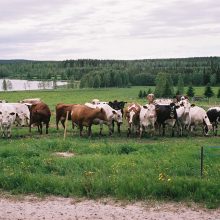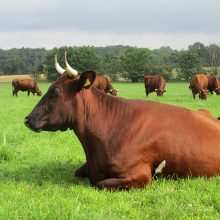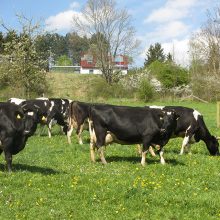Local versus Holstein dairy breeds under organic production
The animal article of the month for March is “Comparison of performance and fitness traits in German Angler, Swedish Red and Swedish Polled with Holstein dairy cattle breeds under organic production” by Bieber et al.

The use of local breeds is recommended by organic regulations, nevertheless modern Holstein breeds are widely used on European organic dairy farms and breed comparisons performed under similar production intensities on organic farms are scarce. We therefore compared performance, fertility and health of (1) the local breed Original German Angler to the modern German Holstein, both kept under low-intensity production conditions on German organic dairy farms, and (2) the two local breeds Swedish Polled and Swedish Red to the modern breed Swedish Holstein living in mixed herds under intensive production conditions on Swedish organic farms.

Our results show that milk yield differences in favour of the modern Holstein breeds were less pronounced under low- intensity production conditions in Germany than under the more intensive production conditions in Sweden. All local breeds had a higher milk fat and protein content compared to the respective modern Holstein breeds. Numerically all fertility figures studied were better in the local breeds, though statistical differences were only present (tendency or significant) for days open in both countries and for number of services until conception in the Swedish data set. Proportion of test day records with a somatic cell count content of ≥ 100 000 cells per ml milk, used as an indicator for subclinical mastitis and therewith udder health, did not differ between breeds in any of the countries.

This might be due to the fact that management factors have a pronounced effect on the somatic cell count level and our data originated from pre-selected farms of similar management types in Germany and compared breeds within mixed herds in Sweden. German breeds did not differ regarding the proportion of cows with veterinary treatments of any kind, while the local breed Swedish Red had a lower proportion of cows with general veterinary treatments and specific treatments due to udder problems compared to Swedish Holstein. No breed differences were found regarding proportion of cows treated due to fertility problems or diagnosis of claw or leg problems during claw trimming in Sweden.
We conclude that future breed comparisons need to take into account differing production intensities within organic farming more closely in order to derive sound recommendations on suitable choice of breeds and thus meet the recommendations of the European organic regulations in this aspect.
The animal article of the month for March “Comparison of performance and fitness traits in German Angler, Swedish Red and Swedish Polled with Holstein dairy cattle breeds under organic production” is freely available for a month.
Authors: A. Bieber, A. Wallenbeck, A. Spengler Neff, F. Leiber, C. Simantke, U. Knierim and S. Ivemeyer
The animal Article of the Month is selected by the Editor-in-Chief and is freely available for one month. View the recent selections





